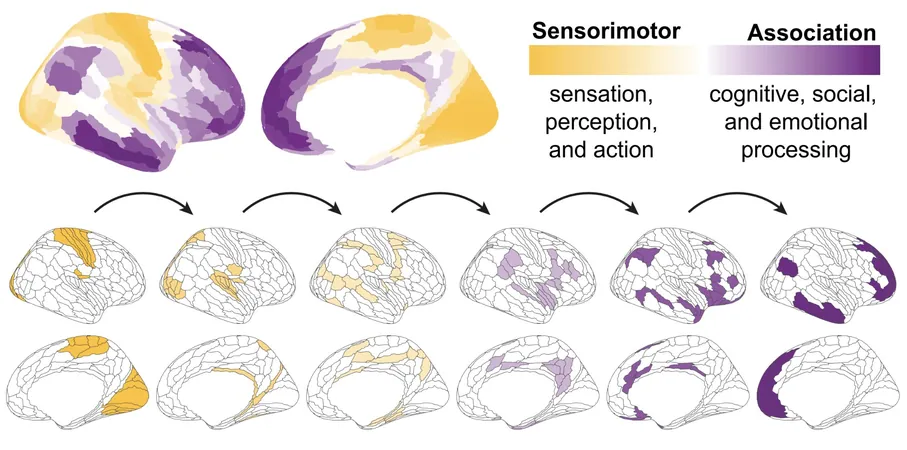
Unlocking the Brain's Secret: How the Thalamus Shapes Development and Adaptability!
2025-08-10
Author: John Tan
The Thalamus: More Than Just a Relay Station!
Human brain development is a fascinating journey that unfolds over a lifetime, beginning with basic functions like movement and sensory perception and advancing to complex abilities such as decision-making. Recent research from the University of Pennsylvania reveals that the thalamus—a deep-seated brain structure known for processing sensory information—plays a pivotal role in this developmental timeline.
Revolutionary Study Reveals New Insights!
Led by Dr. Theodore Satterthwaite and his team, the findings published in *Nature Neuroscience* challenge traditional views of the thalamus as merely a relay station. Instead, they suggest it actively regulates the timeline and hierarchical pattern of brain development.
"We investigated how various human cortex regions exhibit unique plasticity time windows during childhood and adolescence," explains Dr. Valerie J. Sydnor, the study's first author. This research highlights the difference in plasticity reduction across sensorimotor and cognitive brain areas as kids mature.
Shedding Light on Neuroplasticity!
The researchers sought to unravel how adaptations in the brain's cortical regions are timed. By leveraging previous animal studies, they examined structural connections between the thalamus and the cortex—eager to see how these were linked to developmental changes.
Using cutting-edge diffusion magnetic resonance imaging (MRI), the team mapped these connections safely and non-invasively. This technique enabled them to understand how water molecules travel within brain tissues, revealing essential neuronal pathways.
Creating a New Atlas of Connections!
The analysis involved compiling data from diverse groups of children and adolescents aged 8 to 23 from various locations, showing creativity and thoroughness in their methods. They constructed a new atlas outlining the structural connectivity between the thalamus and cortical areas, identifying over 200 connections!
The Thalamus: The Brain’s 'Timekeeper'?
Sydnor notes, "Our data indicate that the thalamus likely plays a more active role in determining when cortical regions are plastic, indicating when they’re adaptable and vulnerable." This suggests the thalamus may act like a timekeeper, coordinating the strength of connections with cortical regions as children develop.
Crucially, this maturation trajectory is aligned with cognitive and psychological outcomes, indicating how the thalamus influences more than just sensory processing.
Revolutionizing Developmental Strategies!
The study highlights that prolonged thalamic connections correspond with extended neuroplasticity, suggesting that strengthening these links can enhance cognitive, social, and emotional capabilities. The researchers are exploring how to use this insight to boost development in children and adolescents through enriched environments.
A Call to Action for Future Research!
Looking ahead, the team is eager to uncover more mechanisms regulating plasticity and understand how environmental factors can be leveraged to support brain development. Their work opens up exciting pathways for interventions that could significantly aid youth in becoming more resilient and adaptable.
As they delve deeper into the complexities of neuroplasticity, we may soon unlock new strategies to empower the next generation!




 Brasil (PT)
Brasil (PT)
 Canada (EN)
Canada (EN)
 Chile (ES)
Chile (ES)
 Česko (CS)
Česko (CS)
 대한민국 (KO)
대한민국 (KO)
 España (ES)
España (ES)
 France (FR)
France (FR)
 Hong Kong (EN)
Hong Kong (EN)
 Italia (IT)
Italia (IT)
 日本 (JA)
日本 (JA)
 Magyarország (HU)
Magyarország (HU)
 Norge (NO)
Norge (NO)
 Polska (PL)
Polska (PL)
 Schweiz (DE)
Schweiz (DE)
 Singapore (EN)
Singapore (EN)
 Sverige (SV)
Sverige (SV)
 Suomi (FI)
Suomi (FI)
 Türkiye (TR)
Türkiye (TR)
 الإمارات العربية المتحدة (AR)
الإمارات العربية المتحدة (AR)